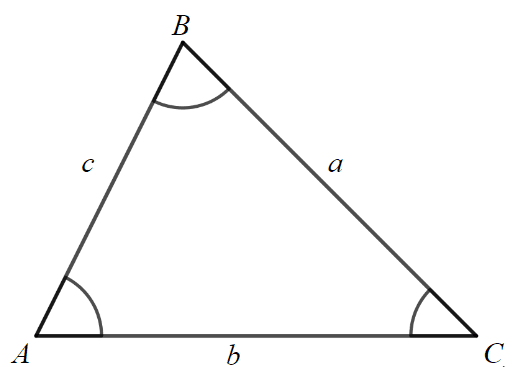Myths about teaching can hold you back


- Year 11•
- Higher


- Year 11•
- Higher
The area of any triangle
I can derive the formula for the area of any triangle.
These resources were made for remote use during the pandemic, not classroom teaching.
Switch to our new teaching resources now - designed by teachers and leading subject experts, and tested in classrooms.
Lesson details
Key learning points
- The formula for the area of a right-angled triangle is 0.5 x base x perpendicular height
- With an equilateral or isosceles triangle, you can use Pythagoras' theorem to find the height
- If you know one of the base angles, you can use the sine ratio to find the perpendicular height
- Doing this leads to the formula 0.5absinC
Keywords
Area - The area is the size of the surface and states the number of unit squares needed to completely cover that surface.
Sine function - The sine of an angle (sin(θ°)) is the y-coordinate of point P on the triangle formed inside the unit circle.
Common misconception
Using any two side lengths for the sine formula.
It must be two side lengths and the angle between them. So any two side lengths of the triangle can be used so long as you also use the angle between them.
To help you plan your year 11 maths lesson on: The area of any triangle, download all teaching resources for free and adapt to suit your pupils' needs...
To help you plan your year 11 maths lesson on: The area of any triangle, download all teaching resources for free and adapt to suit your pupils' needs.
The starter quiz will activate and check your pupils' prior knowledge, with versions available both with and without answers in PDF format.
We use learning cycles to break down learning into key concepts or ideas linked to the learning outcome. Each learning cycle features explanations with checks for understanding and practice tasks with feedback. All of this is found in our slide decks, ready for you to download and edit. The practice tasks are also available as printable worksheets and some lessons have additional materials with extra material you might need for teaching the lesson.
The assessment exit quiz will test your pupils' understanding of the key learning points.
Our video is a tool for planning, showing how other teachers might teach the lesson, offering helpful tips, modelled explanations and inspiration for your own delivery in the classroom. Plus, you can set it as homework or revision for pupils and keep their learning on track by sharing an online pupil version of this lesson.
Explore more key stage 4 maths lessons from the Non right-angled trigonometry unit, dive into the full secondary maths curriculum, or learn more about lesson planning.

Licence
Prior knowledge starter quiz
6 Questions
Q1.Match the polygon with the formula for calculating its area.
Square -
Area = $$l^2$$
Triangle -
Area = $$\frac{bh}{2}$$
Parallelogram -
Area = $$b\times h$$
Trapezium -
Area = $$\frac{1}{2}(a + b)h$$
Circle -
Area = $$\pi\times r^2$$
Q2.Match the areas of these triangles with their dimensions.
Area = 15 cm$$^2$$ -
A triangle with perpendicular height = 5 cm and base = 6 cm
Area = 40 cm$$^2$$ -
A triangle with perpendicular height = 10 cm and base = 8 cm
Area = 6 cm$$^2$$ -
A triangle with perpendicular height = 3 cm and base = 4 cm
Area = 2 cm$$^2$$ -
A triangle with perpendicular height = 2 cm and base = 2 cm
Q3.A regular hexagon is made up of 6 equilateral triangles. The total area of the regular hexagon is 120 cm$$^2$$. The area of one triangle is cm$$^2$$.
Q4.A right-angled triangle has a height of 8 cm and a base of 5 cm. Work out the length of the hypotenuse to 1 decimal place.
Q5.A right-angled triangle has a height of 4 cm and a hypotenuse of 15 cm. Work out the length of the base to 1 decimal place.
Q6.A rectangle has a width of 5 cm and a diagonal length of 13 cm. The area of the rectangle is cm$$^2$$.
Assessment exit quiz
6 Questions
Q1.Match the areas of these triangles with their dimensions.
Area = 45 cm$$^2$$ -
A triangle with perpendicular height = 10 cm and base = 9 cm
Area = 9 cm$$^2$$ -
A triangle with perpendicular height = 6 cm and base = 3 cm
Area = 1 cm$$^2$$ -
A triangle with perpendicular height = 1 cm and base = 2 cm
Area = 2 cm$$^2$$ -
A triangle with perpendicular height = 2 cm and base = 2 cm
Q2.A right-angled triangle has a height of 13 cm and a hypotenuse of 20 cm. The area of the triangle to 1 decimal place is cm$$^2$$.
Q3.A triangle has two adjacent lengths of 8 cm and 9 cm with an angle in between of 53°. The area of the triangle to 1 decimal place is cm$$^2$$.
Q4.Area = $$\frac{1}{2}ab\text{sin}C$$, despite a, b and C being explicit in the formula, they just mean two adjacent sides and the angle between them. Select other formulas for the area.

Q5.Match the areas with the dimensions of the triangle.
23.0 cm$$^2$$ -
The adjacent lengths are 7 cm and 9 cm with a 47° angle in between.
26.3 cm$$^2$$ -
The adjacent lengths are 12 cm and 6 cm with a 47° angle in between.
6 cm$$^2$$ -
The adjacent lengths are 3 cm and 4 cm with a 90° angle in between.
2.4 cm$$^2$$ -
The adjacent lengths are 1 cm and 6 cm with a 53° angle in between.
$$9\sqrt{3} \;$$ cm$$^2$$ -
The adjacent lengths are 6 cm and 6 cm with a 60° angle in between.

